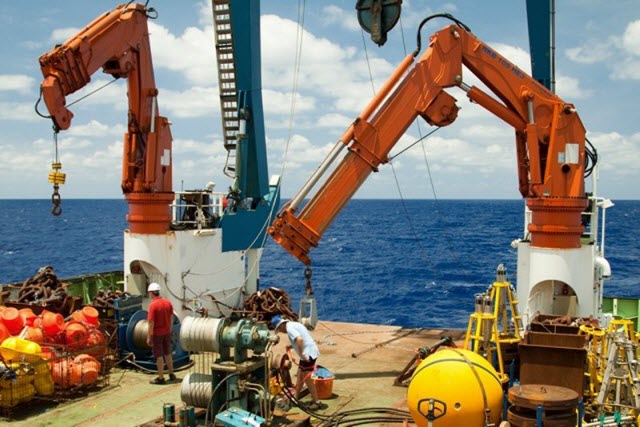 The RAPID moorings being deployed.Photo credit: National Oceanography CentreThe change to the new set of climatic conditions is associated with a cooling of the Atlantic, and is likely to bring drier summers in Britain and Ireland, accelerated sea-level rise along the northeast coast of the United States, and drought in the developing countries of the Sahel region. Since this new climatic phase could be half a degree cooler, it may well offer a brief reprise from the rise of global temperatures, as well as resulting in fewer hurricanes hitting the United States.
The RAPID moorings being deployed.Photo credit: National Oceanography CentreThe change to the new set of climatic conditions is associated with a cooling of the Atlantic, and is likely to bring drier summers in Britain and Ireland, accelerated sea-level rise along the northeast coast of the United States, and drought in the developing countries of the Sahel region. Since this new climatic phase could be half a degree cooler, it may well offer a brief reprise from the rise of global temperatures, as well as resulting in fewer hurricanes hitting the United States.
The study, published in Nature, proves that ocean circulation is the link between weather and decadal scale climatic change. It is based on observational evidence of the link between ocean circulation and the decadal variability of sea surface temperatures in the Atlantic Ocean.
Lead author Dr Gerard McCarthy, from the NOC, said: “Sea-surface temperatures in the Atlantic vary between warm and cold over time-scales of many decades. These variations have been shown to influence temperature, rainfall, drought and even the frequency of hurricanes in many regions of the world. This decadal variability, called the Atlantic Multi-decadal Oscillation (AMO), is a notable feature of the Atlantic Ocean and the climate of the regions it influences.”
These climatic phases, referred to as positive or negative AMO’s, are the result of the movement of heat northwards by a system of ocean currents. This movement of heat changes the temperature of the sea surface, which has a profound impact on climate on timescales of 20-30 years. The strength of these currents is determined by the same atmospheric conditions that control the position of the jet stream. Negative AMO’s occur when the currents are weaker and so less heat is carried northwards towards Europe from the tropics.
The strength of ocean currents has been measured by a network of sensors, called the RAPID array, which have been collecting data on the flow rate of the Atlantic meridonal overturning circulation (AMOC) for a decade.
Dr David Smeed, from the NOC and lead scientist of the RAPID project, adds: “The observations of AMOC from the RAPID array, over the past ten years, show that it is declining. As a result, we expect the AMO is moving to a negative phase, which will result in cooler surface waters. This is consistent with observations of temperature in the North Atlantic.”
Since the RAPID array has only been collecting data for last ten years, a longer data set was needed to prove the link between ocean circulation and slow climate variations. Therefore this study instead used 100 years of sea level data, maintained by the National Oceanography Centre’s permanent service for mean sea level. Models of ocean currents based on this data were used to predict how much heat would be transported around the ocean, and the impact this would have on the sea surface temperature in key locations.
Co-author Dr Ivan Haigh, lecturer in coastal oceanography at the University of Southampton, said: “By reconstructing ocean circulation over the last 100 years from tide gauges that measure sea level at the coast, we have been able to show, for the first time, observational evidence of the link between ocean circulation and the AMO.”
The change to the new set of climatic conditions is associated with a cooling of the Atlantic, and is likely to bring drier summers in Britain and Ireland, accelerated sea-level rise along the northeast coast of the United States, and drought in the developing countries of the Sahel region. Since this new climatic phase could be half a degree cooler, it may well offer a brief reprise from the rise of global temperatures, as well as resulting in fewer hurricanes hitting the United States.
To continue reading this article, sign up for FREE to

Membership is FREE and provides you with instant access to eNewsletters, digital publications, article archives, and more.



 The RAPID moorings being deployed.
The RAPID moorings being deployed.






